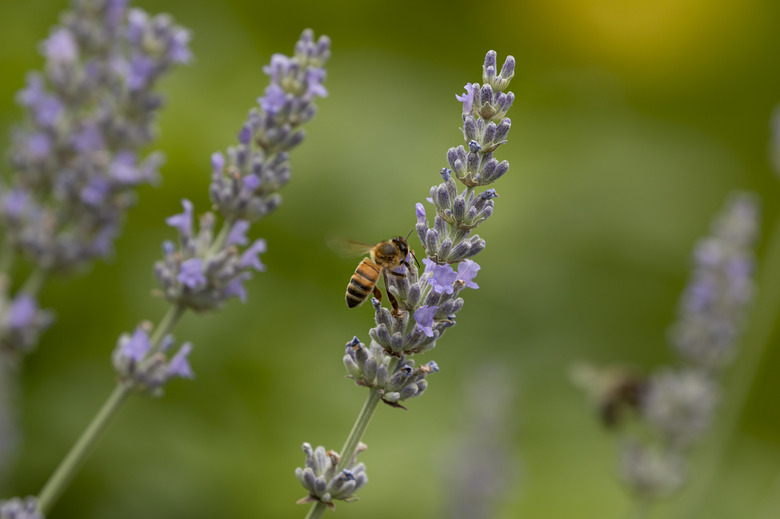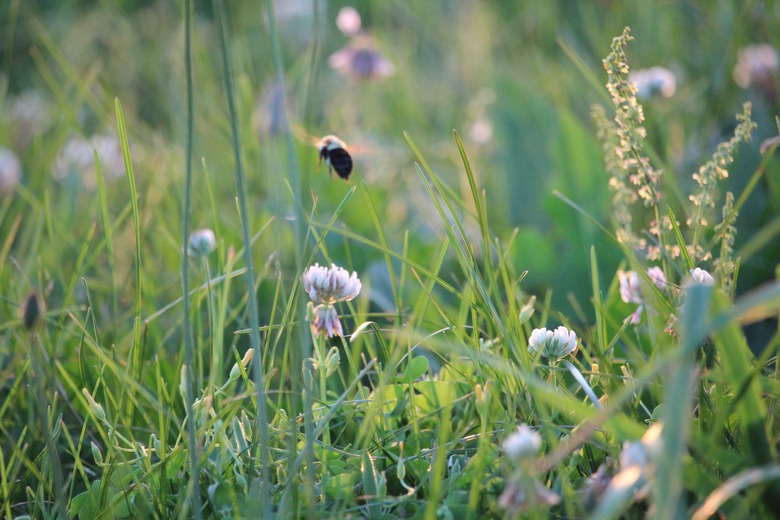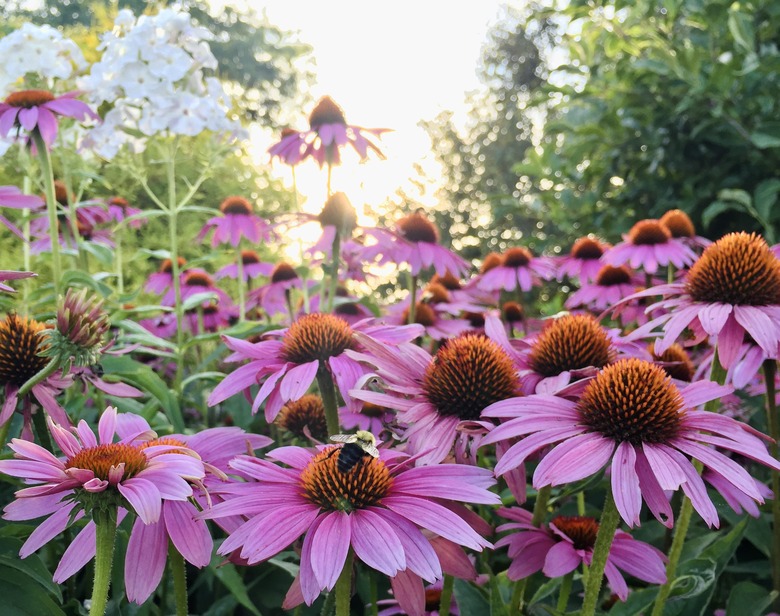Creating A Garden To Attract Bees
We may receive a commission on purchases made from links.
- Learn about local bees
- Ban pesticides in your garden
- Allow yard weeds to bloom
- Offer suitable habitats for hives
- Provide a safe water source
- Learn how to attract bees
- Additional Guidelines for Attracting Bees
- Winter Food Sources for Bees
- Spring Bulbs That Attract Bees
- Summer Blooms for Bees
- Autumn Bee-Friendly Blooms
If you want to increase yields in your vegetable garden, herb garden, berry patch or orchard, it's time to plant a flower garden to attract bees. According to the University of Arkansas Cooperative Extension Service, these industrious insects pollinate over 80 percent of our cultivated food crops in addition to thousands of native plants. In short, bees do us a great service, and we'd suffer without them.
The best way to nurture our relationship with bees is to plant a garden full of the flowers they love, provide convenient and safe habitats and offer a bee-friendly source of water. With all of these amenities, you're sure to attract bees in droves and experience an uptick in your crop yields.
Creating a bee garden doesn't have to be tedious. Bees actually prefer perennials because they tend to produce a higher volume of nectar. Some of the best plants for bees are also native to the United States, which means they shouldn't need too much pampering. With a little planning, you can establish a beautiful bee sanctuary of any size.
Learn About Local Bees
Learn About Local Bees
Many different kinds of bees exist, and not all of them gather nectar the same way. Before you plan the perfect bee garden for the wrong type of bee, discover which bees frequent your area, how they get their food, which flowers they prefer and where they make their nests.
You'll probably see three broad types of bees in your garden: honeybees, carpenter or mason bees, and bumblebees. All of them are important pollinators, but they gather nectar in different ways and are attracted to different plant species. Plan your garden with all of them in mind.
For example, honeybees are small enough to wiggle inside small, tubular flowers. Bumblebees, carpenter bees and solitary bees are often too big to follow suit. Instead, they need open-faced flowers on which to land. Failing to plan a bee garden with food for these larger species could result in "nectar robbing." This occurs when bees "drill" into the nectar source from outside the flower, bypassing the pollen and providing no pollination whatsoever.
Ban Pesticides in Your Garden
Ban Pesticides in Your Garden
A bee-friendly garden has to be a pesticide-free zone. Many pesticides indiscriminately kill all invertebrates, including bees and other beneficial insects. Pesticides can also linger in the environment or get passed on to the birds and mammals that eat the poisoned insects. Supporting bees means supporting a healthy ecosystem, and pesticides just don't play a role in that pursuit.
Fortunately, banning pesticides in your garden doesn't mean you have to let the unwanted, pesky bugs ruin your flowers. In fact, by allowing your garden to become an oasis for all, you'll naturally attract predatory insects that feed on aphids, slugs and other unwanted insects.
Until this food chain becomes established, you can rely on safe alternatives, like neem oil, which is nontoxic to bees ... if properly used. Neem, however, can harm some of your plants, so in your pursuit of a bee-friendly pesticide option, always consult the product label to see if a certain plant may be sensitive to neem. In addition, try to apply all remedies at night, when pests come out to feed but bees retreat to their shelters.
Allow Yard Weeds to Bloom
Allow Yard Weeds to Bloom
One effortless way to encourage bees to visit your property involves changing the way you define a healthy lawn. Those lush, green carpets represent a wasteland as far as bees are concerned. As long as your homeowners' association won't dole out fines or penalties for doing so, lay off the broadleaf herbicides and allow dandelions (Taraxacum officinale, USDA plant hardiness zones 5-9) to blossom once again in your yard. Bees love them, and they're an excellent spring food source for these busy pollinators.
If you want to go a step further, overseed your lawn with a mix of clover (Trifolium spp.). Bees will flock to flower heads throughout the season. As an added perk, the clover clippings will add nitrogen to the soil every time you mow the lawn.
If you're able to dedicate an area of your property to wildflowers, allow chicory (Cichorium intybus, zones 3-8), Joe Pye weed (Eutrochium purpureum, zones 4-9), ironweed (Vernonia noveboracensis, zones 5-9), and various native asters (Symphyotrichum spp.) to grow. Bees also like knapweed, bindweed and knotweed, but these are considered invasive and noxious in many areas. Pull these up by their roots if you see them creeping into your yard and plant a more manageable food source for your local bees.
Offer Suitable Habitats for Hives
Offer Suitable Habitats for Hives
To successfully attract bees, don't just invite them over for dinner — ask them to move in! Bees have been known to fly up to five miles from their hives or nests to find food, but in reality, most bees will remain within a one to two mile radius of their home. This tendency to stay close to home can work against you if all the good bee habitats are too far away from your garden.
A bee hotel is suitable for solitary bee species and consists of predrilled holes in a block of wood or dozens of hollow bamboo tubes arranged in fun shapes. Consider erecting sacrificial untreated fence posts for the bees that prefer to create their own tunnels. Honeybee swarms are attracted to hollow spaces in trees. However, you may need to go the extra mile and use bait or pheromones to bring this type of bee into your backyard since their numbers have dwindled dramatically in recent years.
For an all-natural approach, plant native bushes, like American elderberry (Sambucus canadensis, zones 4-9), or clumping ornamental grasses, like prairie switchgrass (Panicum virgatum, zones 5-9). Stack rocks or logs to create natural cavities and sheltered spaces. Finally, create patches of bare dirt undisturbed by tilling, mulching or encroaching plants. Many bee species burrow underground in such areas.
Provide a Safe Water Source
Provide a Safe Water Source
Did you know that bees need to drink water too? A clean water source integrated among nectar-filled flowers will turn your yard into a true all-you-can-eat buffet for bees. However, bees aren't great swimmers. They easily drown in pools, ponds and buckets.
To combat this problem, create a bee waterer out of a shallow rubber feed pan. The rough rubber texture gives bees something to grip. To make it even more bee-friendly, fill it with a few large stones. When you add water, make sure the tops of the stones remain above the water line so that any clumsy, soaked bees can climb to safety and dry off.
Learn How to Attract Bees
Learn How to Attract Bees
Bees do not land on just any flower. They specifically land on flowers that produce pollen, which provides protein and other nutrients for bees, and nectar, which is the sugary substance that gives bees their energy. And as they fly from flower to flower, the pollen that collects on their legs and other body parts also pollinates the flowers. We have observant botanists to tell us which flowers contain plenty of nectar, but how do bees decide where to forage?
As it happens, bees rely heavily on their sense of sight. They cannot see the color red at all, so they aim primarily for yellow, blue and white flowers. Bees also see ultraviolet light. When humans use special lenses to see ultraviolet light too, another bee beacon appears: little "landing strips" on some flowers' petals, telling bees exactly where to find that sweet nectar.
Since we can't see these markings without special equipment, we can rely on other clues to help us choose bee-friendly flowers at the local nursery, including the shape of the flower. Bell-shaped flowers, like those on snapdragons (Antirrhinum majus, zones 7-10), allow smaller bee species to scoot inside and get absolutely covered in pollen on their way to the nectar deep within. Bees can also easily land and feed on open-faced flowers, like a classic daisy. Avoid complex flowers, like roses (Rosa spp.), peonies (Paeonia spp.) and carnations (Dianthus spp.); bees can't easily scoot the petals out of the way to reach the nectar.
Additional Guidelines for Attracting Bees
Additional Guidelines for Attracting Bees
When planning a bee garden, keep three important rules in mind:
- Choose a location in full sun.
- Create dense clumps of flowers.
- Plan for early and continuous bloom.
With the exception of bumblebees, bees cannot regulate their own body temperature, so they prefer to fly around in the sunshine. Dense plantings make it easy for a bee to fly from one flower to the next without expending too much energy, so your garden is sure to become a favorite destination. Finally, a garden that constantly offers flowers throughout the year, including late winter or early spring, will enjoy regular visits from bees.
Winter Food Sources for Bees
Winter Food Sources for Bees
If you see a bee on a cool day in winter, it's probably a bumblebee. Other types of bees will wait until temperatures warm up past about 55 degrees Fahrenheit before they leave their nest and search for food. Attracting bees to your garden in late winter is especially crucial if you have early blooming fruit trees, like cherries or plums (both in the Prunus genus), which won't set fruit without a visit from these pollinators.
Plant winter flowers toward the back of your bee garden. That way, you'll have a clear view of them when it counts thanks to the absence of foliage on the other plants, but they won't dominate the scene during summer.
Bees are sure to linger in your garden if you plant these winter-blooming flowers:
- Lenten rose (Helleborus orientalis, zones 4-9)
- Snowdrops (Galanthus nivalis, zones 3-7)
- Heather (Erica carnea, zones 7-9)
- Winter aconite (Eranthis hyemalis, zones 3-7)
Spring Bulbs That Attract Bees
Spring Bulbs That Attract Bees
An excellent way to offer spring blooms for bees without crowding the garden is to focus on planting bulbs. These poke out of the ground in late winter or early spring and look great as dense plantings. When the leaves start to turn yellow or brown, cut them at ground level to make room for other plants' erupting foliage and blooms. It's like having two gardens in one.
Are you short on space? Plant the bulbs in containers. You can save and replant the same bulbs for about five years. Remember that bulbs are happiest in moist but well-draining soil.
Bees seem to particularly like:
- Crocus (Crocus spp.)
- Hyacinth (Hyacinthus spp.)
- Iris (Iris spp.)
- Allium (Allium spp.)
Summer Blooms for Bees
Summer Blooms for Bees
It's not hard to find summer flowers suitable for bees. With so many options, consider planting the species that bees seem to prefer most of all.
According to a study published in Environmental Entomology, bumblebees show a preference for bigleaf lupine (Lupinus polyphyllus, zones 4-8), nettle leaf giant hyssop (Agastache urticifolia, zones 3-9) and Rydberg's penstemon (Penstemon rydbergii, zones 4-10). Significant food sources for honeybees in summer include fireweed (Chamaenerion angustifolium, zones 2-7), annual sunflower (Helianthus spp.) and various types of clover (numerous genera and species).
Other great flowers that attract bees in summer include:
- English bluebell (Hyacinthoides non-scripta, zones 5-8)
- Snapdragons (Antirrhinum majus, zones 7-10)
- Borage (Borago officinalis, annual)
- Coneflower (Echinacea spp.)
- Lungwort (Pulmonaria officinalis, zones 3-8)
- Hollyhock (Alcea rosea, zones 2-10)
- Bee balm (Monarda spp.)
- Jacob's ladder (Polemonium caeruleum, zones 4-8)
- Bellflower (Campanula spp.)
- Carpet bugle (Ajuga spp.)
- Lavender (Lavandula spp.)
Autumn Bee-Friendly Blooms
Autumn Bee-Friendly Blooms
Most bees continue collecting nectar until temperatures dip below 55 degrees Fahrenheit. Then, they hunker down in their nests and stay warm until the temperatures become agreeable.
Make sure they have plenty of food to keep them going through warm spells in autumn by planting late-blooming flowers. Place these toward the back of your garden so that the summer-blooming flowers hide their tall, awkward stems until the colorful flowers burst forth.
In autumn, bees particularly rely on:
- Asters (Symphyotrichum spp.)
- Goldenrod (Solidago spp.)
- Sedum Autumn Joy
(Hylotelephium 'Herbstfreude' AUTUMN JOY, zones 3-9) - Blue mist shrub (Caryopteris spp.)
References
- The Wildlife Trusts: How to Attract Bumblebees to Your Garden
- The British Beekeepers Association: How Far Does a Bee Fly and How Does it Navigate?
- Illinois Wildflowers: Descriptions of Families, Sub-Families, and Tribes of Long-Tongued Bees
- University of Arkansas Cooperative Extension Service: The Importance of Pollinators
- Keeping Backyard Bees: What Do Bees Do All Winter?
- Environmental Entomology: Plant Selection by Bumble Bees (Hymenoptera: Apidae) in Montane Riparian Habitat of California
- NASA Honey Bee Net: Honey Bee Forage Map


